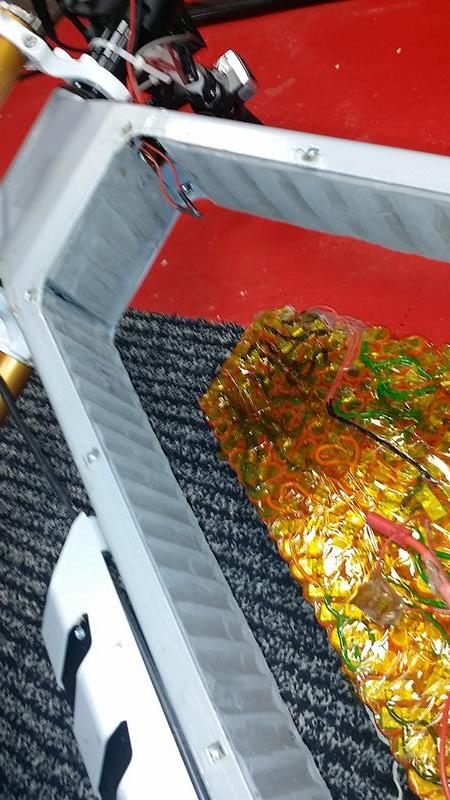Here are the final values.
The values are in amp hours, that is all my charger displays. The time is 1 year difference, from July 2016 to July 2017.
Basement:
2016 --- 2017
2.56 --- 2.56 3.3 volts
2.52 --- 2.53 3.3 volts *2017 slightly higher for some reason.
2.51 --- 2.50 3.3 volts
2.54 --- 2.51 3.7 volts
2.56 --- 2.52 4.1 volts
-------------------------------------------------------------------------------
Garage:
2.53 --- 2.52 3.3 volts
2.53 --- 2.50 3.7 volts
2.54 --- 2.48 3.7 volts *outlier here, will run through charger again, but I did short corner of cell and burned it slightly
2.53 --- 2.49 4.1 volts
--------------------------------------------------------------------------------
Attic:
2.53 ---- 2.46 3.7 volts
----------------------------------------------------------------------------
Freezer
2.54 --- 2.55 3.3 volts
2.54 ---- 2.53 3.7 volts
---------------------------------------------------------------------
Fridge:
2.55 --- 2.55 3.3 volts
2.55 --- 2.54 3.7 volts
----------------------------------------------------------------------
Inside garage 6 months for winter, basement 6 months for summer.
2.53 --- 2.51 3.6 volts
Here are findings:
3.3 storage volts had the lowest capacity loss. Made little difference where cell was stored.
Freezer and Fridge had the best results for 3.7 volts.
The attic had the worst capacity loss, which also had the highest temps by far and biggest temp swings.
The basement had similar results as the garage.This could be because the garage is colder for 6 months out of the year, but hotter in the summer, but not too much hotter in the summer. So it averaged out.
The garage with much higher temp flucuations than the very consistent temps in the basement had little effect on capacity loss. Average temps matter more than stable temps.
The single cell that was placed in the garage during winter and basement during summer, to give cooler stored conditions had best results for 3.6 volt cell not in the refrigerator or freezer.
Average capacity loss per year in percentage. (not freezer or fridge)
4.1 volts = 1.6%
3.7 volts = 1.2%
3.3 volts = 0% to .4%
3.3 volts freezer or fridge = 0%
3.7 volts freezer or fridge = .4%
Best way to store cells:
3.3 volts storage is by far the best way to store 18650 cells.
Freezer or fridge will also reduce the capacity loss, colder is better.
Best to keep bike in basement in the summer and the garage in the winter. Always try to put cells in coldest place.
Thoughts:
The test showed what we all pretty much knew, lower stored voltage and lower stored temps are better. It also showed that you can expect on average about 1% capacity loss per year on your 18650 cells that is not from charge/discharge cycles.
Keeping the bike topped off at 4.1 volts isn't a huge killer, but will cause faster capacity loss.
1% capacity loss is also what my bike pack with 280 of these cells showed in the first year, so most of the loss was from age and not so much from use of the cells.
Most important thing is to discharge your pack to 3.3 volts or as low as you can go when not using the bike. Make sure to disconnect it from controller if stored for long periods of time because it may over discharge your pack if connected to anything.
Moving bike outside to garage in the winter may be better than keeping cells in the warmer basement.
I personally charge my bike right before use and don't leave it stored at a high voltage.
Freezing cells at 0 degrees F / -17 degree C had no ill effects, but didn't show any better results than the fridge at 34 F. This was probably due to my capacity resolution is only .01 amp hours.
The values are in amp hours, that is all my charger displays. The time is 1 year difference, from July 2016 to July 2017.
Basement:
2016 --- 2017
2.56 --- 2.56 3.3 volts
2.52 --- 2.53 3.3 volts *2017 slightly higher for some reason.
2.51 --- 2.50 3.3 volts
2.54 --- 2.51 3.7 volts
2.56 --- 2.52 4.1 volts
-------------------------------------------------------------------------------
Garage:
2.53 --- 2.52 3.3 volts
2.53 --- 2.50 3.7 volts
2.54 --- 2.48 3.7 volts *outlier here, will run through charger again, but I did short corner of cell and burned it slightly
2.53 --- 2.49 4.1 volts
--------------------------------------------------------------------------------
Attic:
2.53 ---- 2.46 3.7 volts
----------------------------------------------------------------------------
Freezer
2.54 --- 2.55 3.3 volts
2.54 ---- 2.53 3.7 volts
---------------------------------------------------------------------
Fridge:
2.55 --- 2.55 3.3 volts
2.55 --- 2.54 3.7 volts
----------------------------------------------------------------------
Inside garage 6 months for winter, basement 6 months for summer.
2.53 --- 2.51 3.6 volts
Here are findings:
3.3 storage volts had the lowest capacity loss. Made little difference where cell was stored.
Freezer and Fridge had the best results for 3.7 volts.
The attic had the worst capacity loss, which also had the highest temps by far and biggest temp swings.
The basement had similar results as the garage.This could be because the garage is colder for 6 months out of the year, but hotter in the summer, but not too much hotter in the summer. So it averaged out.
The garage with much higher temp flucuations than the very consistent temps in the basement had little effect on capacity loss. Average temps matter more than stable temps.
The single cell that was placed in the garage during winter and basement during summer, to give cooler stored conditions had best results for 3.6 volt cell not in the refrigerator or freezer.
Average capacity loss per year in percentage. (not freezer or fridge)
4.1 volts = 1.6%
3.7 volts = 1.2%
3.3 volts = 0% to .4%
3.3 volts freezer or fridge = 0%
3.7 volts freezer or fridge = .4%
Best way to store cells:
3.3 volts storage is by far the best way to store 18650 cells.
Freezer or fridge will also reduce the capacity loss, colder is better.
Best to keep bike in basement in the summer and the garage in the winter. Always try to put cells in coldest place.
Thoughts:
The test showed what we all pretty much knew, lower stored voltage and lower stored temps are better. It also showed that you can expect on average about 1% capacity loss per year on your 18650 cells that is not from charge/discharge cycles.
Keeping the bike topped off at 4.1 volts isn't a huge killer, but will cause faster capacity loss.
1% capacity loss is also what my bike pack with 280 of these cells showed in the first year, so most of the loss was from age and not so much from use of the cells.
Most important thing is to discharge your pack to 3.3 volts or as low as you can go when not using the bike. Make sure to disconnect it from controller if stored for long periods of time because it may over discharge your pack if connected to anything.
Moving bike outside to garage in the winter may be better than keeping cells in the warmer basement.
I personally charge my bike right before use and don't leave it stored at a high voltage.
Freezing cells at 0 degrees F / -17 degree C had no ill effects, but didn't show any better results than the fridge at 34 F. This was probably due to my capacity resolution is only .01 amp hours.





